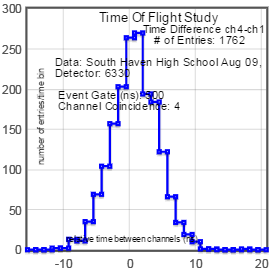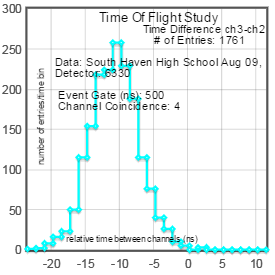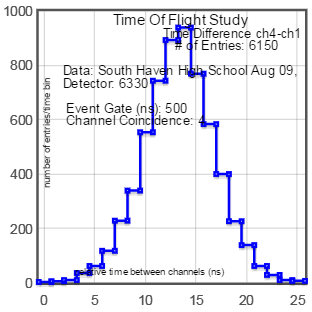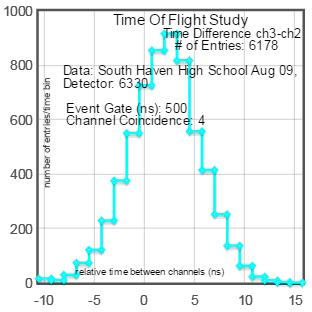Muon Time of Flight Study
08/09/2016
Abstract
The purpose of this study was to determine the average speed of a moun in the atmosphere. The procedure set up the counters in a stacked arrangement. After collecting data overnight, the order of the counters was flipped. The average velocity of a muon was 2.72 x 10^8 m/s, which is nearing the speed of light (3.0 x 10^8 m/s).
Introduction
Observing the incidence of muons in the earth's atmosphere led us to wonder how fast a muon travels through the atmosphere. Given that the average lifespan of a muon is measured in nano-seconds, it seems reasonable that the speed is FAST. So, our goal was to measure the average speed of a muon.
Musons are 206 times heavier than the electron, and are highly penetrating particles and are therefore able to reach the ground.
Procedures
Setting up the cosmic ray detector with the counters in a stacked configureation, and placing the first and last counter at a minimum distance of 2 m, data will be collected overnight. At the beginning of the next day, the configuration of the counters will be flipped, and data will be collected for this configuration. An analysis of distance vs time for both configureation will allow the determination of the speed of the muons.
The speed can be calcuated by using the formula distance between the counters/time.
Results
We created a histogram of the data collected for the following:
| Trial | mean (ns) | standard deviation (ns) | speed of muon (m/s) | Average speed of muon (m/s) |
| Ch. 1-4 dist. 1.99 m | 13.5 | 3.41 | 3.2^8 | |
| Ch. 4-1 dist. 1.99 m | 0.71 | 3.52 | ||
| 2.96^8 | ||||
| Ch. 2-3 dist. 1.94 m | -10.3 | 3.55 | 2.72^8 | |
| Ch. 3-2 dist. 1.94 m | 1.93 | 3.53 |
* See Figures 1-4 for histograms of mean and standard deviation
Figures

Figure 1. Ch. 4 to 1. Counters at distance of 1.99m

Figure 2. Ch. 2 to 3. Counters at distance of 1.94m

Figure 3. Ch. 1 to 4. Counters at a distance of 1.99

Figure 4. Ch. 3 to 2. Counters at a distance of 1.94m






Discussion and Conclusions
The speed of light is 2.99^8 m/s and our calculated average speed of the muon is 2.96^8 m/s which approaches the speed of light. Probable errors in our experiment were inexact measurement of the distance of the detectors. Our muon speed was calculated with only a limited number of data collection points. A more exact number should be calcuated.
Our error of mean is 0.08 ns which is our degree of uncertainty. (Trial 1 was 0.080 and Trial 2 was 0.083.)
Bibliography